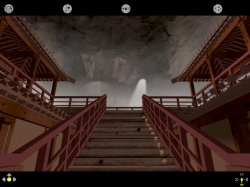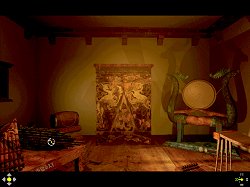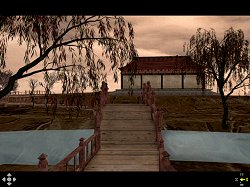|
Qin: Tomb of the Middle Kingdom
 The Time of the Warring States in ancient Chinese history lasted over 200 years. It was a time of struggle and violence as the large Chinese states fought to gain control. It was also a time of great cultural development, and Confucianism, Taoism and Legalism all emerged in this period. As such, it is also referred to as the One Hundred Schools period.
It ended with the rise of the Qin (pronounced Ching) dynasty in the third century BC. The ruler Ying Zheng was determined to unite all China, a goal he achieved 17 years later, culminating in his self declaration as the First Emperor.
Chinese history plays a big part in this game, and whilst Qin leans somewhat heavily on the edutainment button, for those who don't mind leaning that way it is a reasonable collection of puzzles, plus a glimpse into ancient Chinese culture. The Time of the Warring States in ancient Chinese history lasted over 200 years. It was a time of struggle and violence as the large Chinese states fought to gain control. It was also a time of great cultural development, and Confucianism, Taoism and Legalism all emerged in this period. As such, it is also referred to as the One Hundred Schools period.
It ended with the rise of the Qin (pronounced Ching) dynasty in the third century BC. The ruler Ying Zheng was determined to unite all China, a goal he achieved 17 years later, culminating in his self declaration as the First Emperor.
Chinese history plays a big part in this game, and whilst Qin leans somewhat heavily on the edutainment button, for those who don't mind leaning that way it is a reasonable collection of puzzles, plus a glimpse into ancient Chinese culture.
It is a bit drab looking, being predominantly done in tones of brown, but it compensates somewhat with a rather excellent musical score, utilising the instruments and style of the period. It is also a solitary experience, befitting a tomb but lacking in pageant and ceremony.
This is no ordinary tomb. Taking 700,000 labourers 30 years to complete, it is an underground empire, complete with palace. You will discover more as you solve the puzzles that will allow you access to other parts of the tomb.
 The puzzles are a good mix of the language and culture of the Qin Dynasty, but it would be going too far to say they are integrated into the game in any meaningful sense. There is a "plot" of sorts, but it essentially bookends the game. By this I mean that except for the start and the end, the story has nothing to do (that I could see) with anything that you were doing whilst playing the game. It felt like someone told the makers after they had finished that they would sell more copies to adventure game players if it had a story, so they added "once upon a time" and "they all lived happily (or not) ever after".
So I won't spoil what story there is other than to say that it involves multi-national media conglomerates and the fascination of Ying Zheng with eternal life. There are 4 endings depending upon your final choice. The puzzles are a good mix of the language and culture of the Qin Dynasty, but it would be going too far to say they are integrated into the game in any meaningful sense. There is a "plot" of sorts, but it essentially bookends the game. By this I mean that except for the start and the end, the story has nothing to do (that I could see) with anything that you were doing whilst playing the game. It felt like someone told the makers after they had finished that they would sell more copies to adventure game players if it had a story, so they added "once upon a time" and "they all lived happily (or not) ever after".
So I won't spoil what story there is other than to say that it involves multi-national media conglomerates and the fascination of Ying Zheng with eternal life. There are 4 endings depending upon your final choice.
The puzzles are many and varied, and I confess the solving of a couple (including a testing music puzzle) escaped me. You can get clues by looking diligently about and by referring to the database. It may throw light where before there was just shadow. You should also use your translator. Chinese inscriptions are everywhere, and they can prod you in the right direction if you can discern the deeper meaning within many of them.
I must admit that at times I thought there was a much deeper game going on that I just wasn't playing. Perhaps I wasn't spending enough time pondering and contemplating the wisdom I was reading and hearing, and/or not enough time in the database. Rather, I was more intent on finding and solving the next puzzle and as such might have rushed things. Yet visually I was not that enticed by the settings, and they did not encourage me to stroll around and reflect on things. The music tried hard, and some settings were better than others, but in the end it engaged me as an aurally interesting puzzle fest, and nothing more.
Qin is a slide show style of game, similar to Myst. There is sporadic use of animations in the scenes, which actually suits the environment. Many scenes are quite detailed, and some almost beautiful, despite the limited use of colour.
 You can play with the keyboard or mouse, but I expect you will settle for the keyboard to move around and the mouse for the other things. You can move using the mouse, but to do so you will have to click the directional arrow in the lower left screen corresponding to the direction you want to go or turn. I found this entailed a lot of unnecessary shuttling of the mouse back and forth from the left corner to the game screen, so I used the keyboard arrows to move.
At first you may be fooled by the arrows indicating direction. An arrow to the right does not necessarily mean you will turn 90 degrees. A compass in the lower right hand corner indicates the direction you are facing, and is marked like a watch to indicate where you will be facing if you turn left or right. If it is marked only once, then whether you turn left or right you will be facing in the same direction, which might be a few degrees away from your current direction or a complete about face. If it is marked say 5 times, then clearly there are a lot of different views available in the 360 degrees you can turn from your current position. The compass will help you keep track of your ultimate direction. If you move forward or back, then of course the available views will change. Trust me, it sounds more fiddly than it is.
Active cursors will indicate a variety of actions, and if there is an interaction possible in the view before you, a little yellow indicator will light up. To that end, it is hard to miss an interaction, provided you look at every view available from a particular spot. You will pick up some items, often represented by their Chinese character, but these are limited, and you can only carry one at a time. If you move too far from where it is to be used, it will simply disappear and go back to where you found it.
This makes Qin easier to play than some games, but the puzzles themselves can be difficult. As noted above, often the clues to the puzzle objectives are cryptically (or sometimes philosophically, even mystically) contained in the Chinese inscriptions or dialogue you come across. Be sure to translate everything you see - simply click the translator which appears when you move the mouse to the top of the screen. You can play with the keyboard or mouse, but I expect you will settle for the keyboard to move around and the mouse for the other things. You can move using the mouse, but to do so you will have to click the directional arrow in the lower left screen corresponding to the direction you want to go or turn. I found this entailed a lot of unnecessary shuttling of the mouse back and forth from the left corner to the game screen, so I used the keyboard arrows to move.
At first you may be fooled by the arrows indicating direction. An arrow to the right does not necessarily mean you will turn 90 degrees. A compass in the lower right hand corner indicates the direction you are facing, and is marked like a watch to indicate where you will be facing if you turn left or right. If it is marked only once, then whether you turn left or right you will be facing in the same direction, which might be a few degrees away from your current direction or a complete about face. If it is marked say 5 times, then clearly there are a lot of different views available in the 360 degrees you can turn from your current position. The compass will help you keep track of your ultimate direction. If you move forward or back, then of course the available views will change. Trust me, it sounds more fiddly than it is.
Active cursors will indicate a variety of actions, and if there is an interaction possible in the view before you, a little yellow indicator will light up. To that end, it is hard to miss an interaction, provided you look at every view available from a particular spot. You will pick up some items, often represented by their Chinese character, but these are limited, and you can only carry one at a time. If you move too far from where it is to be used, it will simply disappear and go back to where you found it.
This makes Qin easier to play than some games, but the puzzles themselves can be difficult. As noted above, often the clues to the puzzle objectives are cryptically (or sometimes philosophically, even mystically) contained in the Chinese inscriptions or dialogue you come across. Be sure to translate everything you see - simply click the translator which appears when you move the mouse to the top of the screen.
You can access maps of the tomb as you open areas, and the maps contain hotspots by which you can jump back to specified positions. You will also find some shortcuts as you play.
Like many such games, you can access the database as much or as little as you like. Helpfully, each time you open the database it will come up with a list of topics relevant to your current room or view.
Subtitles are present, which is just as well as almost all the dialogue is in Mandarin. There is not a lot, but I thought it added something to hear the language of the realm in which I was playing. I loathe dubbed movies, and would much prefer to "hear" a game in the language of its location or origin, and read English subtitles.
Playing a game so totally Chinese was diverting in itself. It gave me 8 to 10 hours of reasonable puzzling. It might give a more insightful adventurer something more.
Copyright © Steve Ramsey 2002.
All rights reserved.
System Requirements:
IBM 486-33 processor, Windows 3.1 or 95 (played flawlessly on Win 98), 8 Mb RAM, 6 Mb disc space (20 recommended), 2x CD ROM, 640 x 480 resolution, 256 colours
|
